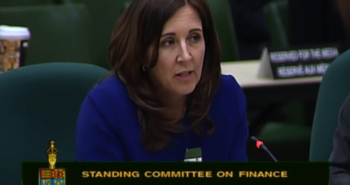CANADIAN UNEMPLOYMENT RATE IN APRIL AT 6.5%–LOWEST RATE SINCE OCTOBER 2008 –BUT ANNUAL WAGE GAINS FELL TO ANOTHER RECORD LOW
 Canada’s economy generated virtually no net new job growth in April, on the heels of a multi-month employment rally that was the strongest in years. Employment has now increased in 15 of the last 17 months with growth over the last year averaging a solid 23,000 per month. The details of the monthly report for April were mixed (with a sharp pull-back in full-time jobs offset by stronger part-time employment) but, on average, more than two-thirds of job gains over the last year have been full-time.
Canada’s economy generated virtually no net new job growth in April, on the heels of a multi-month employment rally that was the strongest in years. Employment has now increased in 15 of the last 17 months with growth over the last year averaging a solid 23,000 per month. The details of the monthly report for April were mixed (with a sharp pull-back in full-time jobs offset by stronger part-time employment) but, on average, more than two-thirds of job gains over the last year have been full-time.
Employment grew by just 3,200 jobs last month, well below the 10,000 forecasted by economists. On a year-over-year basis, however, there were 276,000 more people employed–up 1.5%–and the jobless rate was down 0.6 percentage points. Other positive signs include hours worked numbers that show gains of 1.1% over the past 12 months.
Despite the slowdown in job growth in April, the unemployment rate fell 0.2 percentage points to 6.5%, its lowest level since October 2008. According to Statistics Canada, the decrease reflected the departure of 45,500 people from the labor force. About half of those were youth, meaning many young people looking for work have stopped looking.
Employment among the population aged 55 and older rose by 24,000 in April, mostly in full-time work, and their unemployment rate declined 0.6 percentage points to 5.6%. On a year-over-year basis, people 55 and older had the fastest rate of employment growth (+3.6% or +133,000) compared with the other demographic groups. This is primarily the result of the continued transition of the baby-boom cohort into this older age group.
For men aged 25 to 54, employment declined by 20,000 in April, mostly in full-time work, and their unemployment rate increased 0.3 percentage points to 6.1%. Since August 2016, their employment gains have totalled 81,000. On a year-over-year basis, their unemployment rate was down 0.4 percentage points.
Among women aged 25 to 54, employment held steady in April and their unemployment rate was little changed at 5.1%. Compared with 12 months earlier, employment for this group was up 71,000 (+1.2%), virtually all in full-time work.
Employment for youth aged 15 to 24 was little changed in April, while their unemployment rate fell 1.1 percentage points to 11.7% as fewer of them searched for work. This is the lowest unemployment rate for youth since September 2008. On a year-over-year basis, youth employment was virtually unchanged.
Employment rose in British Columbia and Prince Edward Island, while it was virtually unchanged in the other provinces. In B.C., employment rose by 11,000 last month and the jobless rate was little changed at 5.5%. Job creation has been on a upward trend in the province with sizable increases in four out the past five months. On a year-over-year basis, employment was up 3.4% in B.C.
Although employment held steady in Ontario, the unemployment rate fell 0.6 percentage points to 5.8%, largely due to a decline in the number of youth searching for work. This is the lowest jobless rate for Ontario since January 2001.
In Alberta, April saw little job gain after a period of growth that began in autumn 2016. The jobless rate in the province was 7.9% in April, down 0.5 percentage points from the previous month as fewer people searched for work.
More people were employed in educational services, health care and social assistance, and transportation and warehousing in April. At the same time, employment declined in business, building and other support services, as well as in accommodation and food services.
Public sector employment increased in April, while the number of private sector employees fell. Self-employment was little changed.
Yet, the pace of annual wage rate increases fell to another record low. The pace of annual wage rate increases for permanent employees fell to 0.5% in April, the lowest in records dating back to the late 1990s. The wages puzzle, which has been cited by the Bank of Canada as evidence of slack in the economy, persists. The weak wage growth is in sharp contrast to what would otherwise appear to be a labour market with little or no slack remaining. To be sure, other measures of wages have been stronger (wage growth in the alternative (lagged) Survey of Employment, Payrolls and Hours (SEPH) was 2.4% year-over-year in February) but weaker numbers today from a wage perspective will likely continue to worry the Bank of Canada.
For historical perspective, wage gains have averaged 2.7% over the past decade. Adding to the mystery is that Ontario is the major source of wage sluggishness, with pay increases of 0.2% year-over-year. Full-time jobs also are showing slower wage gains than the national average. Clearly, businesses are very cost conscious, keeping labour costs muted, and economic uncertainty continues to depress the willingness of workers to demand higher wages. This concern can only be enlarged by growing trade tensions between the U.S. and Canada as President Trump continues to threaten to renegotiate NAFTA, already imposing punitive duties on soft wood lumber imports from Canada.
Trade tensions as well as a decline in oil prices to $45 a barrel (WTI) and the continuing troubles with Home Capital have added to downward pressure on the Canadian dollar as it has suffered the weakest performance of any of the Group of Ten currencies, now trading at 72.7 cents U.S.
Provincial Unemployment Rates in April In Descending Order (percent)
(Previous months in brackets)
— Newfoundland and Labrador 14.0 (14.9)
— Prince Edward Island 10.3 (10.1)
— New Brunswick 8.7 (8.4)
— Nova Scotia 8.3 (8.6)
— Alberta 7.9 (8.4)
— Quebec 6.6 (6.4)
— Saskatchewan 6.2 (6.0)
— Ontario 5.8 (6.4)
— British Columbia 5.5 (5.4)
— Manitoba 5.4 (5.5)
U.S. JOB GROWTH REBOUNDS AND JOBLESS RATE FALLS TO LOWEST LEVEL SINCE MAY 2007
U.S. payroll gains rebounded in April by more than forecast and the jobless rate unexpectedly fell to 4.4%, signaling that the labor market remains healthy and should support continued increases in consumer spending.
The 211,000 increase in nonfarm payrolls–beating economist forecasts–followed a 79,000 advance in weather-depressed March that was lower than previously estimated. The recovery in employment was most evident in private sector, service-producing jobs.
While the jobless rate is now the lowest since May 2007 (see chart below), wage increases did moderate slightly in April but is still indicative of real wage gains. This continued support to household incomes should contribute to Q2 consumer spending growth, and overall Q2 GDP growth, which is likely to rebound to over 2.5% following a disappointing first quarter increase of only 0.7%. Average hourly earnings, the main wage measure in the report, rose an expected 0.3% though this did not prevent the year-over-year rate from moderating slightly to 2.5% from 2.6% in March and a Q1 average of 2.7%.
Strengthening U.S. business confidence might be translating into hiring, and the data should keep Federal Reserve policy makers on track to raise interest rates in the coming months after officials declared this week that the first-quarter slowdown is likely to be transitory. The Fed refrained from raising rates this week.


 Canada’s economy generated virtually no net new job growth in April, on the heels of a multi-month employment rally that was the strongest in years. Employment has now increased in 15 of the last 17 months with growth over the last year averaging a solid 23,000 per month. The details of the monthly report for April were mixed (with a sharp pull-back in full-time jobs offset by stronger part-time employment) but, on average, more than two-thirds of job gains over the last year have been full-time.
Canada’s economy generated virtually no net new job growth in April, on the heels of a multi-month employment rally that was the strongest in years. Employment has now increased in 15 of the last 17 months with growth over the last year averaging a solid 23,000 per month. The details of the monthly report for April were mixed (with a sharp pull-back in full-time jobs offset by stronger part-time employment) but, on average, more than two-thirds of job gains over the last year have been full-time.

 This hearing will cast serious doubt on OSFI’s credibility and motives. For as CMHC CEO Evan Siddall has stated, the market consequences of the government’s actions were “fully intended.” The rule changes thus appear to have been purposely targeted and premeditated based on false (or at least questionable) pretenses.
This hearing will cast serious doubt on OSFI’s credibility and motives. For as CMHC CEO Evan Siddall has stated, the market consequences of the government’s actions were “fully intended.” The rule changes thus appear to have been purposely targeted and premeditated based on false (or at least questionable) pretenses. Documents, documents and more documents. Yes that’s right you will need to provide your Dominion Lending Centres mortgage broker with as many documents that we request upfront as possible. Why? Because the more supporting documentation you have available will help us as brokers to find you your best mortgage options. If you don’t have everything on hand e-mail a PDF of what you have and start digging up the rest as soon as possible.
Documents, documents and more documents. Yes that’s right you will need to provide your Dominion Lending Centres mortgage broker with as many documents that we request upfront as possible. Why? Because the more supporting documentation you have available will help us as brokers to find you your best mortgage options. If you don’t have everything on hand e-mail a PDF of what you have and start digging up the rest as soon as possible. December’s jobs report was unambiguously strong showing employment gains of 53,700 (0.3%), the result of gains in full-time work. Finally, for the first time this year, full-time jobs outpaced part-time. The unemployment rate increased 0.1 percentage points to 6.9% as more people entered the labour force. This is evidence that the economy may be absorbing the slack that’s kept interest rates near record lows.
December’s jobs report was unambiguously strong showing employment gains of 53,700 (0.3%), the result of gains in full-time work. Finally, for the first time this year, full-time jobs outpaced part-time. The unemployment rate increased 0.1 percentage points to 6.9% as more people entered the labour force. This is evidence that the economy may be absorbing the slack that’s kept interest rates near record lows. In a move to help BC citizens and residents buy their first home, the BC government announced today that it is launching a new program to augment down payments for first-time buyers. The B.C. Home Owner Mortgage and Equity Partnership program contributes to the amount first-time homebuyers have already saved for their down payment, providing up to $37,500, or up to 5% of the purchase price, with a 25-year loan that is interest-free and payment-free for the first five years. Through the program, the Province is investing about $703 million over the next three years to help an estimated 42,000 B.C. households enter the market for the first time.
In a move to help BC citizens and residents buy their first home, the BC government announced today that it is launching a new program to augment down payments for first-time buyers. The B.C. Home Owner Mortgage and Equity Partnership program contributes to the amount first-time homebuyers have already saved for their down payment, providing up to $37,500, or up to 5% of the purchase price, with a 25-year loan that is interest-free and payment-free for the first five years. Through the program, the Province is investing about $703 million over the next three years to help an estimated 42,000 B.C. households enter the market for the first time.